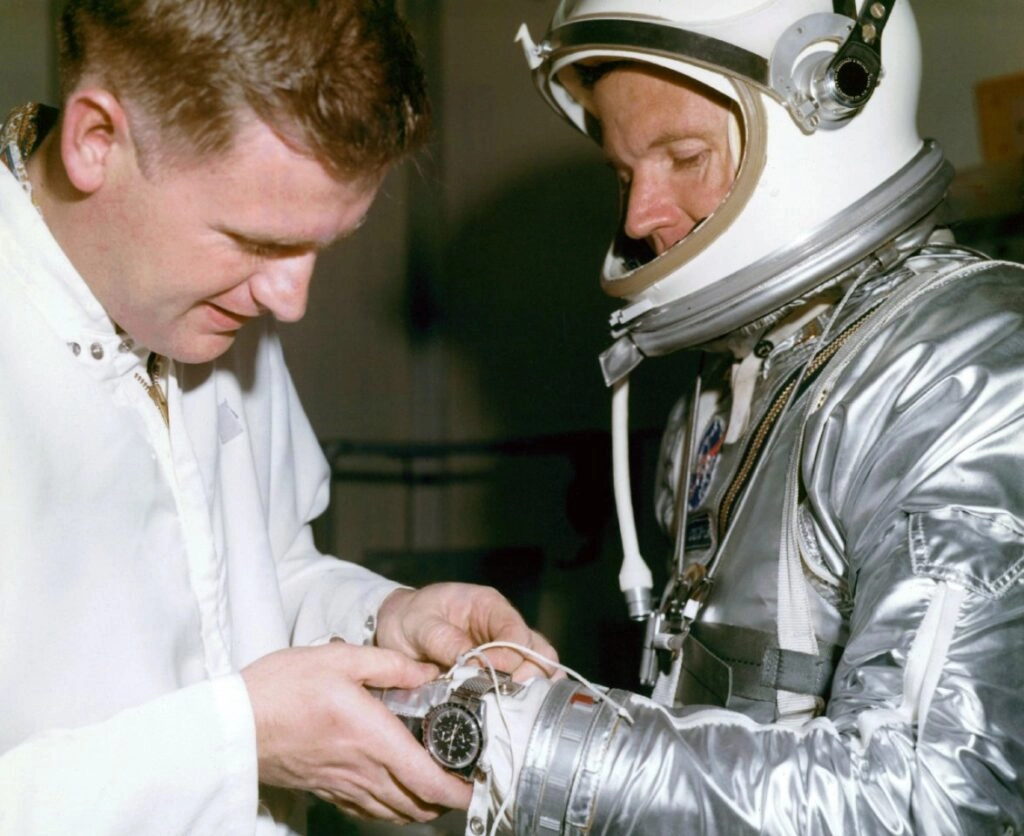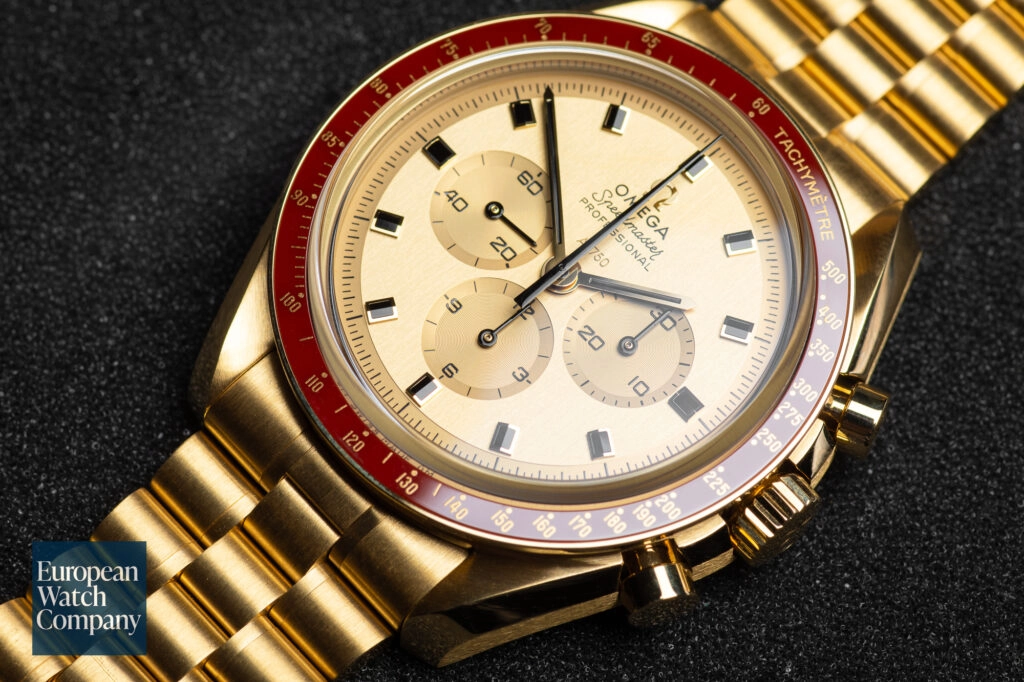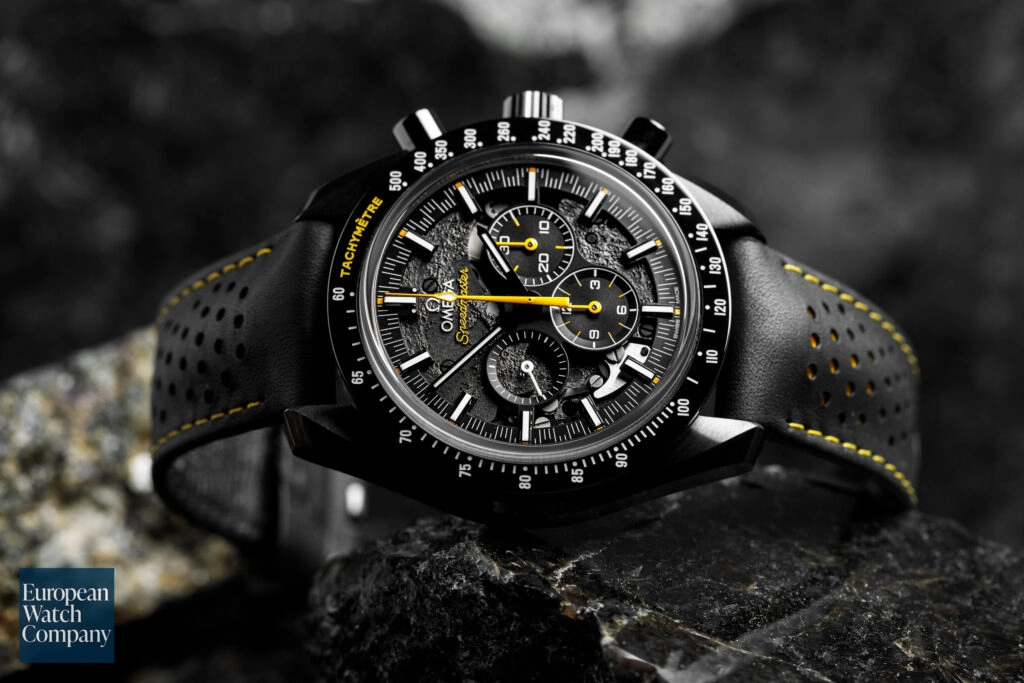A Quick Guide To The Omega Speedmaster with 5 Top Watches
Buyers Guides
The Omega Speedmaster is one of the most iconic watches around, and even non-watch folk likely recognize the mighty Speedy. Introduced in 1957 as part of Omega's "Professional" line, the Speedmaster was initially designed as a high-precision chronograph for motorsport enthusiasts. However, an entirely different domain catapulted the Speedmaster into legendary status — namely, space exploration: the Final Frontier.

Walter ‘Wally’ Schirra wearing his Omega Speedmaster
The Speedmaster's journey to the Moon began in 1962 when astronaut Wally Schirra wore his Omega Speedmaster CK2998 during the Mercury-Atlas 8 mission. This caught NASA's attention, leading to rigorous tests in 1964 to find a watch capable of withstanding the extreme conditions of space. These tests included exposure to intense vibrations, temperature extremes, and high-pressure environments. Out of several contenders, including submissions from Rolex and Longines, the Speedmaster emerged victorious. Funnily, not because it succeeded in NASA's testing regime, but because it failed the least. In 1965, it became the first watch officially qualified by NASA for all manned space missions. This qualification laid the groundwork for the Speedmaster's enduring legacy in space exploration.
The Birth of the Moonwatch
The Omega Speedmaster achieved its most iconic moment during the Apollo 11 mission in July 1969 when astronauts Neil Armstrong and Buzz Aldrin made history by walking on the Moon. Aldrin famously wore the Omega Speedmaster Professional, making it the first watch worn on the Moon's surface. From then on, the watch went by its "Moonwatch" moniker and became synonymous with NASA's space missions.

Edwin E. “Buzz” Aldrin, Jr. wearing his Omega Speedmaster during the Moon Landing.
Its reliability was further solidified during the Apollo 13 mission in 1970. When an oxygen tank exploded, threatening the lives of the crew, the Speedmaster played a critical role. Astronauts used the watch to precisely time 14-second critical engine burns that allowed the spacecraft to return to Earth safely. Omega was later awarded NASA's "Silver Snoopy Award" for its contribution to the mission.
Icon Status is Well Deserved
It's hard to argue that the humble Speedy, a tool watch at heart, is not one of the most iconic watches of the 20th century. Beyond its space legacy, it has permeated popular culture and is worn by astronauts, celebrities, and everyday collectors alike. While there are more variations and limited editions of the Omega Speedmaster than you can shake a stick at, key design tenets exist across most models and certainly the OG iterations. Its design is simplistic yet incredibly functional, with key features such as a black dial with contrasting white hands and markers ensuring legibility.
Over the decades, the Speedmaster has maintained its core aesthetic, with only subtle evolutions in movement technology and case materials. That said, if you want something a little more left-field, there's almost certainly a Speedmaster for you. With that in mind, let's look at 5 Speedmasters that rank among the greatest Omega has ever produced.
Omega Speedmaster Moonwatch Professional Ref. 310.30.42.50.01.001

The Omega Speedmaster Moonwatch Professional Ref. 310.30.42.50.01.001 celebrates the OG "Moonwatch", noted for its role in NASA's Apollo missions. This modern iteration retains the classic 42mm case size, crafted in stainless steel with a Hesalite crystal. It houses Omega's Co-Axial Master Chronometer Caliber 3861, offering improved accuracy, magnetic resistance, and reliability over its predecessor, the Caliber 1861. The manual-winding movement pays homage to the original Speedmaster with its Caliber 321, while updates like a more refined bracelet and step-dial add a touch of modernity. Thanks to the combination of heritage and modern features, this iteration of the Omega Speedmaster is the perfect model for collectors looking for their first Speedmaster. After all, collectors rarely ever settle for just one Speedy!
Omega Speedmaster Calibre 321 Ed White 311.30.40.30.01.001

The Omega Speedmaster Calibre 321 "Ed White" Ref. 311.30.40.30.01.001 is a tribute to astronaut Ed White, who wore a Speedmaster during the first American spacewalk in 1965. This model features a 39.7mm stainless steel case with straight lugs, reminiscent of the vintage ST 105.003 "Ed White" model, and is powered by Omega's meticulously reintroduced Calibre 321, visible through the sapphire display case back. With a domed sapphire crystal, black step-dial, and bezel ring in polished black ceramic with the tachymeter scale in white enamel, it's a modern version of one of the most iconic Speedmasters. For me, this is perhaps "the" Speedmaster to have. While not a limited edition per se, it's limited production due to the complexities in producing the 321 movement.
Omega Speedmaster Apollo XI 50th Anniversary 310.60.42.50.99.001

The Omega Speedmaster Apollo XI 50th Anniversary in Moonshine Gold is a limited edition timepiece released in 2019, commemorating the first moon landing. Limited to 1,014 pieces, this model pays homage to the original gold Speedmasters presented to U.S. President Nixon, Vice President Agnew, and all active NASA astronauts at a gala dinner in Houston in 1969 (however, President Nixon had to turn down the gift due to the value of the watch). Crafted from Omega's proprietary 18K Moonshine Gold, which offers a paler hue than traditional yellow gold, the watch features the classic 42mm lyre-lugged case and matching gold bracelet. Its vertically brushed step dial, also in Moonshine Gold, is adorned with facetted onyx hour markers, providing a striking contrast. The burgundy ceramic bezel ring adds a color reminiscent of the original 1969 model. Omega chose the Apollo XI 50th Anniversary to debut its manual-winding Master Chronometer Calibre 3861. A heavyweight both visually and on the wrist, if you're looking for a touch of gold, then you cannot go wrong here.
Omega Speedmaster Dark Side of the Moon Apollo 8-311.92.44.30.01.001

The Omega Speedmaster Dark Side of the Moon Apollo 8, introduced in 2018, commemorates the historic Apollo 8 mission — the first to orbit the Moon and witness its far side, in all its perpetual darkness. This timepiece features a more significant 44.25mm case made of black ceramic and a skeletonized dial, offering a view of the specially decorated hand-winding Caliber 1869 movement. The movement's bridges and main plate are laser-ablated to resemble the Moon's surface, with the dial side representing the near side and the case back depicting the far side. Yellow accents on the dial and hands and a perforated black leather strap revealing a yellow rubber interior add some much-needed contrast, but black and yellow is a classic color combination. The case back is engraved with Command Module Pilot Jim Lovell's words, "We'll see you on the other side," marking the start of the crew's orbit to the dark side of the Moon – never seen before by human eyes. Seconds before the spacecraft disappeared beyond the radio contact range, Lovell spoke these final assuring words to ground control.
Omega Speedmaster Professional Apollo 13 Silver Snoopy Award

Earlier in this article, you may have seen me mention the "Silver Snoopy Award". You may ask what this is precisely, and that's a fair question. What does the lovable cartoon beagle have to do with NASA and space? Well, the Silver Snoopy Award is a prestigious honor presented by NASA to individuals or companies who have significantly contributed to the success of human spaceflight missions. During the Apollo era, NASA adopted Snoopy as the mascot for its safety program in 1968. As its name might suggest, the Omega Speedmaster Professional Apollo 13 Silver Snoopy Award commemorates the Speedmaster's pivotal role during the Apollo 13 mission. This 42mm stainless steel chronograph features a silver dial with blue PVD hour markers and hands, complemented by a blue ceramic bezel with a white enamel tachymeter scale. Notably, the 9 o'clock subdial showcases an embossed silver Snoopy medallion, honoring Omega's receipt of the Silver Snoopy Award in 1970. Rather than displaying the Caliber 3861, the case back presents an animated depiction of Snoopy in his Command and Service Module, orbiting the Moon when the chronograph function is activated. A neat little Easter Egg to see in action!